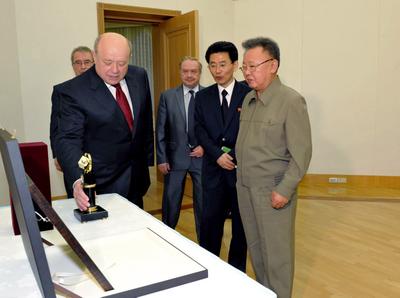A fundamental factor behind the crisis on the Korean peninsula, beginning with the tragic sinking of the Cheonan in March 2010, appears to be North Korean resistance to the US-ROK alliance. This is not new, but escalated to a new level of antagonism. The initial strategic vision of the current ROK administration of Lee Myung-bak was to rapidly and decisively push North Korea to breaking point and unify the two countries — ‘absorbing’ the North.
With the full support of the US, the Lee administration initiated efforts to implement a regime change in Pyongyang. One method used to increase pressure was to exploit crisis situations, sparking international condemnation of North Korea and getting additional sanctions imposed on the DPRK to decisively isolate it and accelerate collapse. This strategy was used following the sinking of the Cheonan. But despite Seoul’s best efforts it was unable to achieve all of its goals in the UNSC (partly because proof supporting the South Korean version of the attack was not persuasive enough). But by accusing Pyongyang of destroying the Cheonan, Lee Myung-bak burned his bridges with the North and cut off his path of retreat in domestic politics — therefore drastically narrowing his options in both areas, forcing him to risk everything and continue with his chosen course of action. As stated by Lee immediately after the sinking, normalisation of inter-Korean relations is impossible before his term in office expires.
But there is another extremely important factor — China. Throughout 2010, the US openly clashed with Beijing on a wide range of issues, including North Korea. By increasing pressure on China to unprecedented levels, Washington (and Seoul) attempted to show Beijing that the price of its support for Pyongyang was excessively burdensome. Recent US-ROK naval maneuvers, that brought an aircraft carrier into the Yellow Sea, were likely primarily aimed at China, even though they were officially conducted as a response to North Korea. But despite these efforts, North Korea’s domestic political environment remains quite stable, and the friendly relations between China and North Korea, ‘cemented by jointly shed blood’, continue to deepen.
Pyongyang knows it is now dealing with a revived long-term US-ROK strategy. Therefore, both the recent incidents, and inevitable future military border incidents, are part of the North’s response. Based on that assumption, and Pyongyang’s past actions, the North’s leaders would not hesitate to use armed resistance, or preemption. The political elite are aware that it is a matter of life and death for their regime and them personally, and are prepared to use all means available in a struggle for survival.
Essentially, North Korea’s recent actions are aimed at giving the US two clear alternatives — either bilateral talks or further development of its nuclear program. By the same token, South Korea is under pressure to choose between dialogue and conflict.
With this understanding, how might the situation be rectified?
First, the situation will never be resolved so long as the Lee government refuses to negotiate with the North.
While many negotiations between the DPRK and its opponents have ended in fiasco, history demonstrates that successful negotiations are possible; the DMZ was mutually discussed, agreed to, and it is still recognised by the North.
The most successful period of strict international monitoring of North Korea’s nuclear program was during the Agreed Framework’s seven years, signed by the US and the DPRK in October 1994. The KEDO program, despite its difficulties, gave the world its first successful collaboration between the North and a range of Western partners.
Yes, North Korean representatives frequently walked out of the negotiations without fulfilling their obligations. But an impartial analyst would note that Western parties also broke and tried to repackage their own obligations. Regarding North Korea’s nuclear program, the historical evidence again confirms that they were successfully subjected to international monitoring, freezing and even sometimes reversal when Pyongyang was in negotiations with interested partners, under obligations they had voluntarily accepted opposite those they recognised as equals. That was the case until very recently, during periods when the terms of the six-party negotiations in Beijing were successfully implemented.
Of course, those were temporary and partial successes. But they made real progress — certainly better than the presently unlimited development of North Korea’s nuclear capability.
Currently, Pyongyang legally considers itself free of all obligations. It immediately rejected the UNSC’s resolutions, and international sanctions are not stopping it from moving forward in the nuclear arena. Plans to force Pyongyang to give up its nuclear program through sanctions and increased isolation simply do not work. Instead, when its leaders are feeling increased threat from outside they maximise efforts to strengthen their ‘nuclear shield’ — and they are prepared to sacrifice much for its sake, including limiting economic freedom and reforms.
The only real, workable method to halt, then limit and, eventually, eliminate North Korea’s nuclear program and capability is for the main players to enter substantive negotiations as soon as possible. And the six-party talk mechanism in Beijing, here, is a workable tool that has provided a store of useful experience (although other international structures to deal with similar problems in the future might very well emerge).
As is well known in the non-proliferation community, advancing non-proliferation and regime change policies concurrently is absolutely incompatible. Anywhere attempts at regime change are staged, successful non-proliferation efforts come to an immediate halt.
Professor Alexander Vorontsov is Head of the Korean and Mongolian Studies Department at the Russian Academy of Sciences’ Institute of Oriental Studies.
An earlier version of this essay was published here at the Nautilus Institute.

